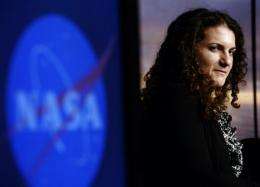NASA's arsenic life-form scientist answers critics

The NASA-funded scientist whose discovery of a bacterium that thrives on arsenic prompted an avalanche of criticism responded Thursday with a statement answering questions about her research.
Felisa Wolfe-Simon, lead author of the study published in the journal Science earlier this month, also reflected about her experience as a young scientist thrust into the heart of a web-fueled controversy.
"The speed of communication is ahead of the sheer time needed to think and get in the lab and work," she wrote on the micro-blogging site Twitter, in an apparent reference to critiques that lit up the blogosphere after the December 2 study.
The microbe, GFAJ, was found in California's arsenic and salt-rich Mono Lake. Researchers said it could survive on arsenic instead of phosphorus, shifting science's definition of the building blocks necessary for life.
Canadian scientist Rosie Redfield ignited a web fury by musing over what she called "flim-flam" research and flaws by "bad scientists."
Other bloggers picked up on it and soon the criticism found its way into mass media as newspapers and magazines reported on the debate over the team's methods, barging in on a realm that is typically dominated by peer-reviewed study in science journals.
Among the chief complaints was that the arsenic detected by the scientists was merely residue and not part of the microbe's DNA.
Questions about the team's findings "tended to focus on whether the bacteria had truly incorporated arsenic into the DNA and whether the microbes had completely stopped consuming phosphorus," Wolfe-Simon's web statement said.
"While the team prefers to address questions through a peer-reviewed process, Felisa Wolfe-Simon and (co-author) Ron Oremland have provided some additional information here as a public service, and to clarify their data and procedures."
She emphasized that the answers had not been peer-reviewed and were "provided on behalf of the authors only as a public information service while more formal review of their responses to comments sent to Science continues."
A list of scientific explanations to three of the top questions is contained in the statement, available online at www.ironlisa.com .
"We freely admitted in the paper and in the press that there was much, much more work to do by us and a whole host of other scientists," it concludes.
"We look forward to working with other scientists, either directly or by making the cells freely available and providing DNA samples to appropriate experts for their analyses, in an effort to provide more insight into this intriguing finding."
Wolfe-Simon and her co-authors have remained largely silent since the controversy erupted, and after her official responses were posted online she let loose with a series of comments on Twitter about the experience.
"Codes of conduct develop as we evolve to cope. Let our paper teach us all something about human nature and our respect for one another," Wolfe-Simon said in one tweet.
"My role as lead and communicating author has been an incredible growing and character building experience," she said.
She also hinted that she may have been at odds with NASA's decision to describe the study ahead of time as offering evidence of extraterrestrial life.
"We were certainly not completely in control of press releases," she tweeted.
"I was involved in the writing of the press release. But 'involved' does not imply in control. We are in control of the science.
"PR machines are just that. We are scientists. I am a scientist.
"As an early career scientist, this has been an experience I look forward to reflecting on... now back to the lab!"
(c) 2010 AFP


















